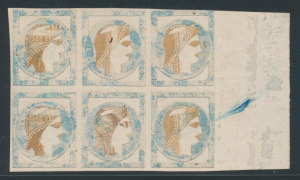Classic French stamps are among the most interesting. The first issues of France are printed by a method of printing called typography. Unlike engraved plates, typography relies on plates that hold a design by having an ink-holding agent that is applied to the plate do the printing rather than having the metal plate itself hold the ink, as is the case in engraving. Typography is a simpler printing method than engraving, but in the hands of capable printers can produce a fine result. But the non-metal aspect of the printing agent means that wear is rapid, and for this reason typography tends not to be used for large printing orders as the quality of the print tends to degrade as the plates wear. The reason why the printers of the first French issues chose not to engrave their stamps is unclear. Perhaps they were unsure that stamps would catch on and that millions would soon be required, and their decision was based on the fact that typography is far cheaper than engraved. But the result is that the plates on which these stamps were printed degraded quickly.
The printers thought of a variety of solutions to the plate wear problem. Most obviously, they retouched the plates where the plate wear was most obvious. These retouches are listed by the specialized French catalogs and are actively collected. But the most interesting method to extend the life of these typograghed plates and retain high printing quality was a method called decoupage. Decoupage were backing sheets that were placed underneath the stamp paper that was being printed on. The purpose was to press that section of the stamp paper upward a bit as it was being printed to compensate for plate wear on a particular part of the sheet above where the backing sheet was placed.
Decoupage was a work in progress. Every few days technicians examined printed sheets and added small bits of paper glued to the decoupage to compensate for that week’s wear. After the stamps were no longer being printed, the printer sold the decoupage sheets to collectors. These have been broken up and specialists add them to their collection to illustrate philately’s more primitive aspect. They are relatively inexpensive, given their fascinating purpose.


